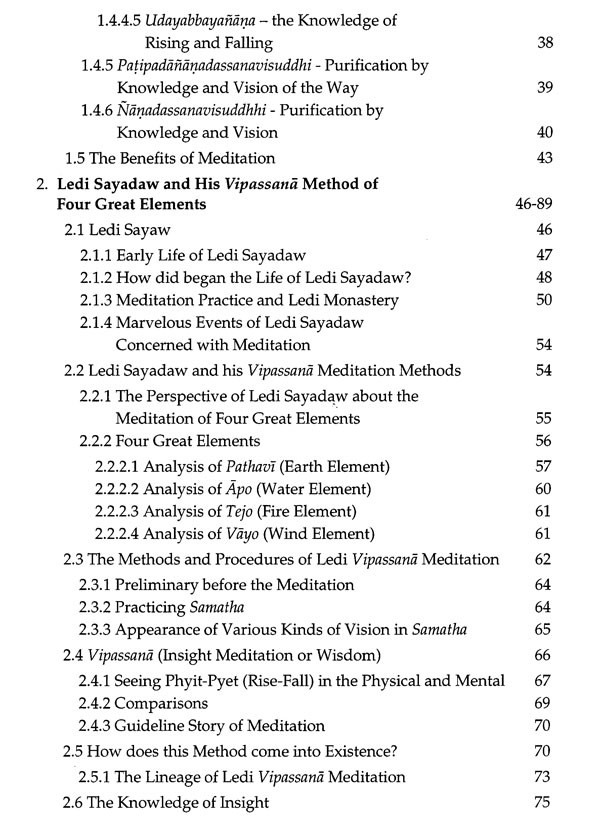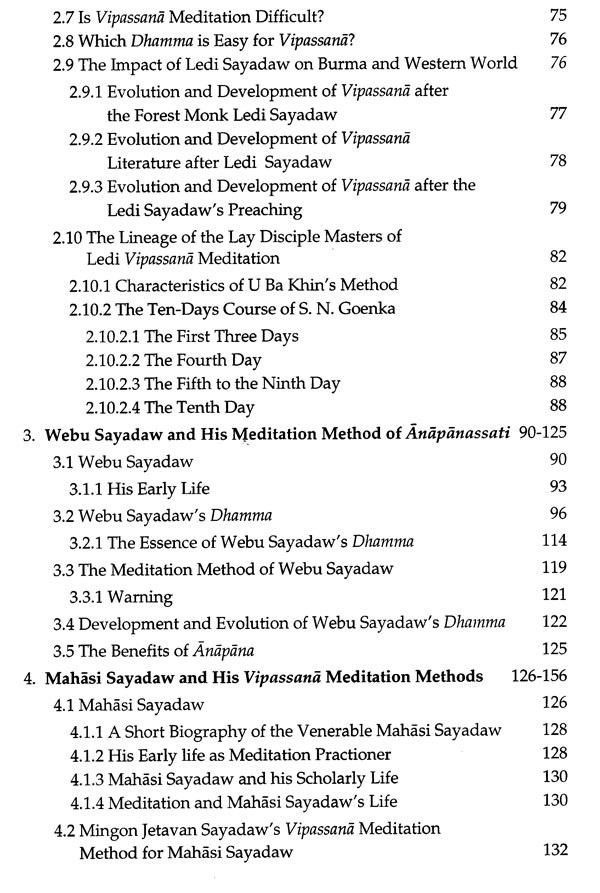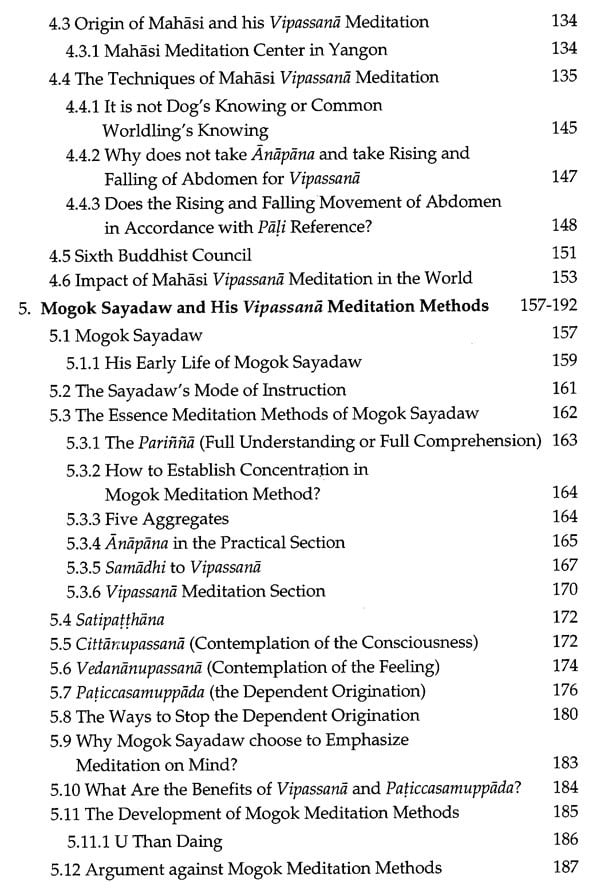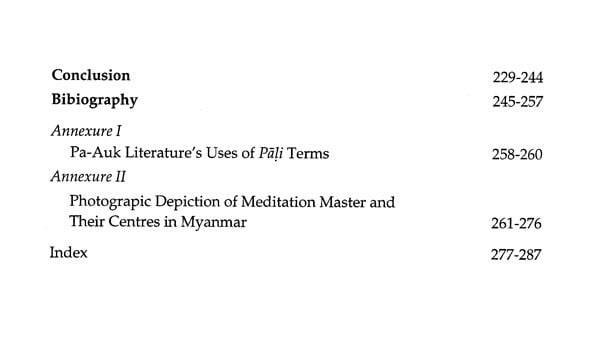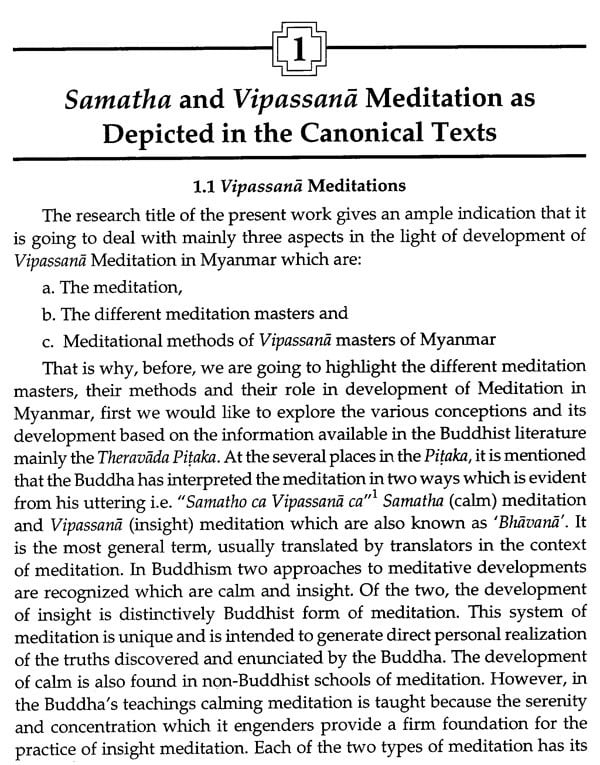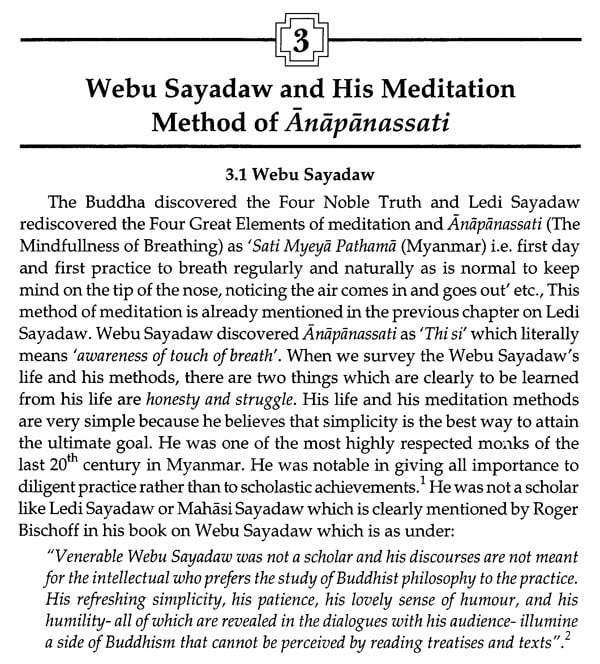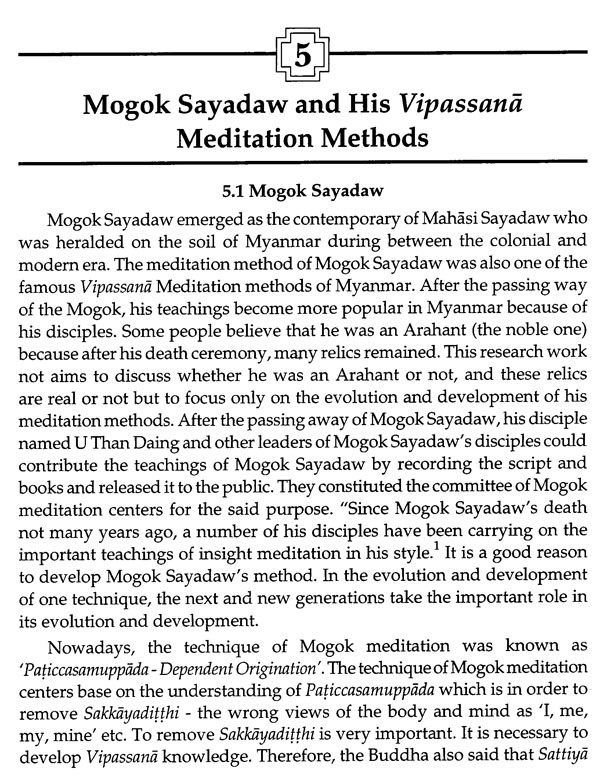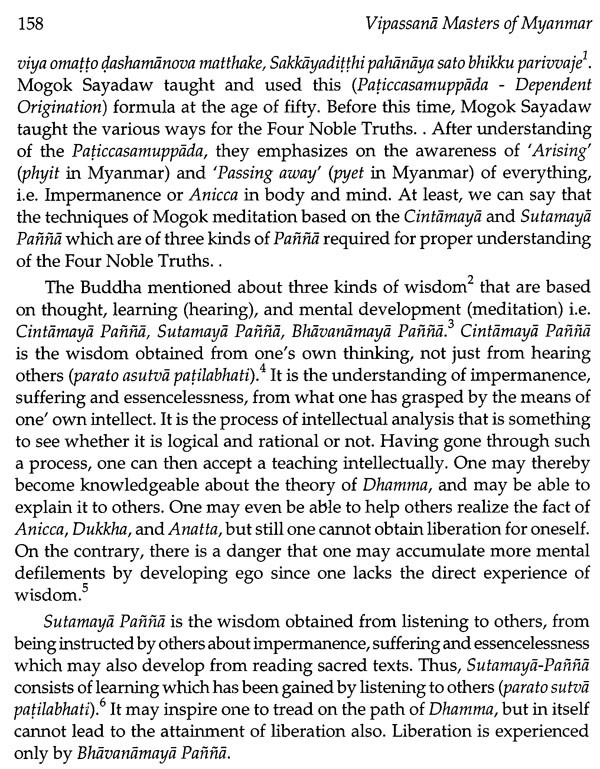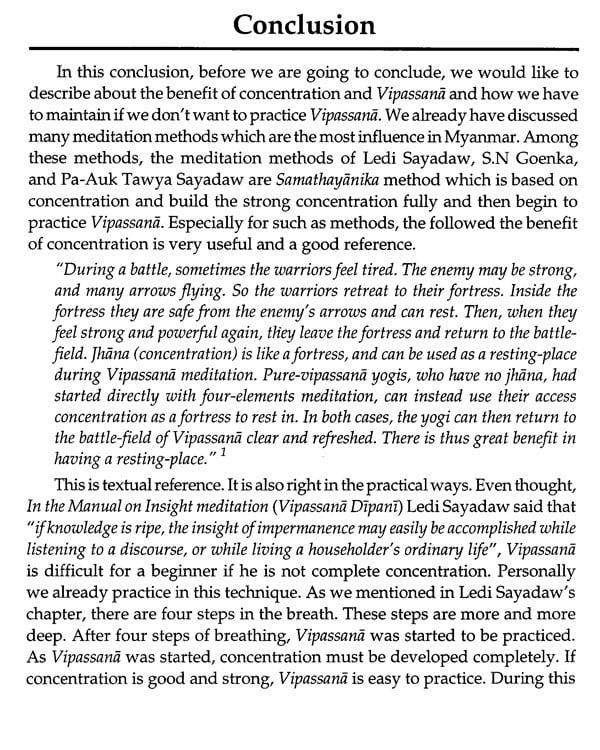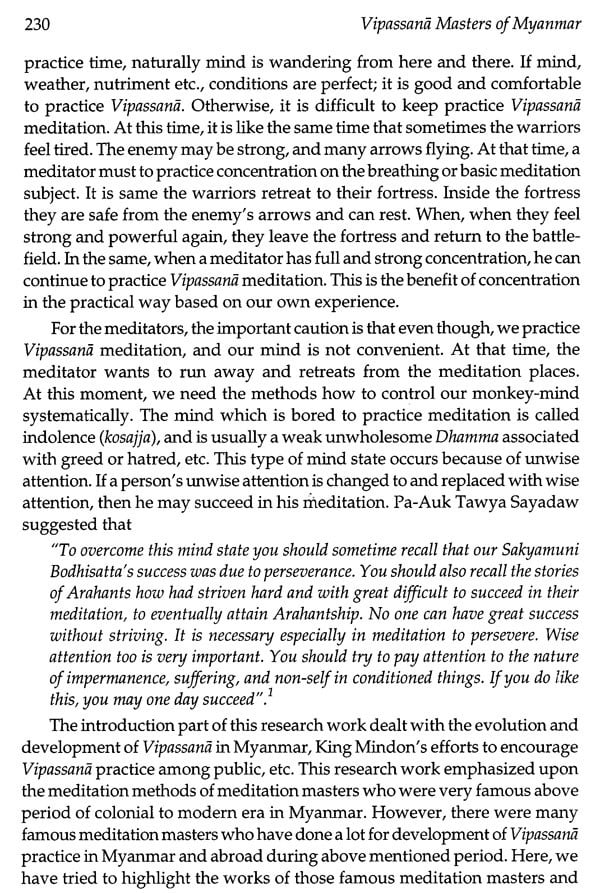
Vipassana Masters of Myanmar
Book Specification
| Item Code: | NBZ983 |
| Author: | Ashin Nyanavara |
| Publisher: | Eastern Book Linkers |
| Language: | English |
| Edition: | 2021 |
| ISBN: | 9788178543987 |
| Pages: | 320 |
| Cover: | HARDCOVER |
| Other Details | 10.00 X 7.50 inches |
| Weight | 790 gm |
Book Description
The present book titled "Vipassana Masters of Myanmar" deals with the life and works offamous Vipassana Masters of Myanmar from colonial to modern era and how they have influenced and contributed in the evolution and development of their methods of Vipassana. The book started with a brief history of Vipassana Meditation in Myanmar. Over 2600 years ago, the Buddha attained Enlightenment in India. Owing to the Vipassana Dhamma taught by the Buddha, many human beings, devas and brahmans were liberated from the cycle of sufferings. The disciples of the Buddha expounded the Dhamma including Vipassana from generation to generations and spread it in whole world and the process is still going on. Sometime, the branches grow and develop more than the trunk. In the same way, although Buddhism declined in India, it is growing and developing in other countries. For instance, although Buddhism and Vipassana were lost in its original land, it was preserved through and unbroken chain of teachers and disciples in Myanmar (Burma). Myanmar is the country where various types of Vipassana meditational methods have been developed from very long time under the able guidance and supervision of various Vipassana Masters viz. LediSayadaw, WebuSayadaw, MahasiSayadaw, MogokSayadaw, Pa-Auk TawyaSayadaw, etc. The book discusses about the benefits of meditation which is the essence of this research work and in the way discovered why each of all meditation masters instructed to follow only their methods. The teachings of all the Masters are same as thefinal destination of all water is to fall into the ocean. In the same way, direction of all meditation methods which are explored and investigated in this book is to Nibbana. When they reach at the ocean, the taste of all water becomes 'salty', in the same, after practicing all techniques of meditation; the final taste is only liberation. In order to taste the liberation of suffering or the ocean of Nibbana by using the various methods of Vipassana meditation is the aim of this reached work. The Buddha also said that "Yo ca vassastamjiveeduppannoasa mahitoekahamjivitamseyyopannavantassajhayino." It does mean that "Better than a hundred years in the life of an ignorant person, who has not control over his senses, is a day in the life of a wise man who cultivates Tranquility and Insight Development Practice"(Dhammapada Verse-111). Later on, Myanmar becomes one of the major Buddhist countries; it has flourished with both the theory (pariyatti) and practice (patipatti) in Southeast Asia. Therefore, in this book author has tried to explore the evolution and development of Vipassana meditation and techniques as expounded by the above mentioned great Meditation Masters of Myanmar.
Nyanavara has spent his early days at Pajjotayon monastery in Monywar Mahasi meditation center situated at Loai Kwaw and Sitagu International Buddhist Academy, founded by the Most Ven. Dr. Nanissara, Sagaing Hills in Upper Myanmar. Currently he has been associated with Sitagu International Buddhist Academy in the capacity of Lecturer, Department of Abhidhamma and Philosophy and also looking after the administrative affairs of the institution. He has completed his Doctoral programme in Buddhist Studies and Civilization from Gautam Buddha University, India in 2017 and also done Master of Philosophy (M. Phil.) in 2013 (Gold Medalist) again from Gautam Buddha University. Before joining Gautam Buddha University, he has completed his Masters degree (M.A) in Buddhist Studies from the Department of Buddhist Studies, University of Delhi in 2012. Before coming to India for his higher studies, he has studied Pali and Buddhist Literature over ten years and passed the Sasanadajadhammasariya Degree which is equivalent to Bachelor of Art degree held by the government of Myanmar in 2006 and the Diploma in Buddhismfrom Sitagu International Buddhist Academy in 2009. Dr. Nyanavara's area of specializations are Buddhist Meditation, Applied Buddhism, Buddhist Ethics, Abhidhamma Philosophy, Buddhist Literature, etc.
Practically he himself has studied and practiced the Mahasi Vipassana Technique in Myanmar and the technique of S.N.Goenka in India in 2012 and Ledi Sayadaw Meditational Techniques from Central Ledi Meditation Center Upper Myanmar in 2015. He attended and presented research papers at number of occasion at different national and international conferences and seminars in Myanmar and abroad as well. In 2016, he has been awarded 'The Peace Volunteer Award' by IBBE, YSSSRF at 6th Global Award Ceremony at Subharti University, Meerut (U.P), India. He has also published research papers in English and Myanmarese language. After completing his PhD program, he has been appointed as Lecture at the department of Abhidhamma and Philosophy, Sitagu International Buddhist Academy, Sagaing Hills, Mandalay, Myanmar.
In 2018, he visited Australia as a Buddhist Missionary and spent almost a year over there and delivered Dhamma Talks and instructed Vipassana meditation methods to the lay people of Sydney region of Australia. At present, he is one of the senior faculty member and also member of Administration Committee of Sitagu International Buddhist Academy, Sagaing, Myanmar. He is of the view that practicing Vipassana is the real research of researches, the body and mind is the research field and the highest degree of that research is Arahatship. Therefore, he focuses to practice Vipassana meditation in order to keep peace himself and his environment.Apart from teaching, he has been a preacher of the Buddha's Dhamma in Myanmar for the lay disciples.
When Buddhism had emerged in India, there were two most powerful schools which had existed at that time were Brahamanic and Sramanic Schools. The Sramana's teachings were generally considered as the part of heterodoxy and they were opposed to the orthodox Brahmanical system. Both of these schools were equally popular among the people in India during the 6th century BC. Therefore, these two religious schools provide us the historical background in which Buddhism has come to emerge. Meditation, as a technique for attaining enlightenment elevates the states of concentration which has practiced in India even before the Buddha's time. Teachers he had gone to before set off on his own had guided him to the higher state of concentration. The Buddha recounts his training under masters Alara Kalama and Uddaka Ramaputta, also the severe ascetic's practices in which he engaged before his discovery the path to Awakening guided him to the higher state of concentration and set off his own meditation theory middle way. The well-known account in the Ariyapariyesana Sutta shows that the Bodhisattva's study under two meditation teachers: Alara Kalama, who reportedly taught him to attain 'the sphere of nothingness' (Akincannayatana), and Uddaka Ramaputta, who guided him towards 'the sphere of neither perception nor non-perception' (Nevasannanasanna-yatana). Thus, it seems to be no reason to deny the historical authenticity which is the most important episodes in that Alara Kalama and Udaka Ramaputta were the teachers of the Siddhattha, but they taught only the meditation of serenity (samatha bhavana).
According to Richard Gombrich, 'the central teachings of the Buddha came as a response to the central teachings of the old Upanisads known as Brhadaranyaka'. Others of the classical Upanisads may have been composed during or soon after the time of the Buddha, and indeed may have been influenced by Buddhism. Gombrich has recently attempted to show at length references to the Upanisads in the earliest Buddhist scriptures. But these referees are directly mocked and criticized by the Buddhists. According to Johannes Bronkhorst, the Buddhist meditation has been originated from the religious practices of ancient India, in response to the ascetic practices of the Jains of Mahavira the founders, also says in his work 'The two traditions of meditation in ancient India', the formless meditation, are borrowed from early Jainism. The goal of the Buddha's teaching was not union with a transcendent absolute but the insight into reality made possible by the deepening calm, joy and awareness that develop as the practitioner passes through the four rupa jhanas. This explanation incidentally makes sense of a puzzling aspect of the story that also found in the Ariyapariyesanasutta, Siddharth's childhood that he experienced the first jhana as he sat beneath a rose-apple tree; the Buddha says he understood the correct path to awakening. The second time came into the passages where the Buddha said to have made his discoveries among the things which had not been heard of before as the Buddha says: Bhikkhave, pubbe ananussutesu dhammesu, cakkhum udapadi, nanam udapadi, panna udapadi, vijja udapadi, aloko udapadi. Among things not heard before by me, monks, vision arose, knowledge arose, wisdom arose, higher knowledge arose, and light arose.
The Buddhist history of Myanmar is mixed with legendary and historical events which they claim Buddhism arrived over 2560 years ago. Since then, both learning and practice have been flourishing until present. A clear representation of early arrival of Buddhism in Myanmar is the glorious Shwedagon Pagoda, in Yangon. There are different claims regarding the arrival of Buddhism in Myanmar. Burmese tradition believes that the Buddhism arrived during the time of the Buddha when Tapussa and Bhallika enshrined the hair relics of the Buddha in Shwedagon Pagoda. According to Myanmar well-known historian and archeologist Khin Maung Nyunt 'subsequently Buddhism arrived for five times from first time of hair relic of the Buddha to the last arrival of Venerable Buddhaghosa in Thaton in 4th century CE'. However, the Sasanavarmsa gives up to six arrivals of Buddhism in Myanmar both from India and Sri Lanka.
Kings and people support Buddhism from the introduction of Buddhism in Myanmar. Due to the pious support of the Myanmar kings, the propagation of Buddhism keeps flourishing. Many great kings had dedicated for Buddhism namely Anawratha, Bodhawpaya, Alungsithu, Bayinnaung, Mindon, and Dhammaceti, who will remain forever in the heart of Myanmar people. Moreover, there are also contributions from devotees towards Pariyatti learning that plays an important role in the meditation movement in Myanmar. Pariyatti (teaching) is the Teaching of the Buddha, (i.e. Tipitaka), and is the foundation for the survival of patipatti (practice). Hence, teaching (Pariyatti) and practice (Patipatti) are comparable to the ground floor of a building, which depends on support of the earth. With the existence of both, there is the possibility of realization (Pativedha) of supramundane states. In the Mahaparinibbana Sutta, the Buddha states, "If the monks dwell rightly, this world will not be empty of Arahants". In order to practice Dhamma rightly, one has to learn Pariyatti comprehensively. Therefore, Pariyatti is the main foundation for practice (Patipatti) which will be conducive for penetration (Pativedha) of the things as they really are (Yathabhutam).
When someone talks about the Vipassana meditation methods and its tradition of Myanmar, the first and foremost thing that came to mind is it Mahasi or Mogok Methods or tradition, which have the largest number of followers, etc. However, the basic meditation is Anapana i.e. the breathing of mindfulness which has not been given emphasis by the above mentioned masters. It's very confusing that why these great meditation masters do don't explain about Anapana widely. This imagination already rooted in my mind for a long time. I am so interested in Anapana that has forced me to find out the Anapana technique at the S. N. Goenka's main meditation center at Igatpuri, Maharshtra, India in December 2011. The Igatpuri centre runs a course for Anapana and the duration of the course is for three days in the ten days course. While I was practicing meditation at the center, I found the trace of Anapana again. My meditation master told me that Webu Sayadaw also practiced this Anapana. When I hear this information, I was so happy because Webu Sayadaw was the most admired meditation master for me in Myanmar. At that very time, I have decided to pursue my higher studies with this topic in mind. When I joined M. Phil. programme, I have wrote by M.Phil. Dissertation based on Vipassana meditation with emphasis of Anapana. After completing my M. Phil. degree and got the much needed training for pursuing another higher degree i.e. Ph. D. I have prepared myself to do my Ph. D. on a topic which is related to Vipassana and its methods. At that time, I have not yet properly decided about the title of my Ph.D. thesis. So, I approached and asked my supervisor to suggest a topic for my Ph. D with an idea that I would like to do my research work on Webu Sayadaw and his meditation technique who emerged as the greatest Meditation master in Myanmar in end of the colonial era and beginning of modern era. After lots of discussion, we came to the conclusion to opt for a tentative titled 'Vipassana Masters of Myanmar'. When I look into the Colonial era, I remember Ledi Sayadaw, who passed away in 1923, was a great scholar in the Pariyatti (learning the doctrine) and patipatti (practice) in the history of Myanmar. Therefore, I decided to start my thesis from Ledi Sayadaw to modern era up to S.N. Goenka's method.
Before starting my research work for Ph. D., I have already done my home work for this particular topic in my mind. In this connection, I have visited many libraries in Myanmar (my native country) to look for the books and articles on meditation masters of Myanmar and their techniques. To name a few libraries like Sitagu International Buddhist Academy Libraries (Sitagu has two libraries: English library and Myanmar library) and from many other places in Myanmar. In the course of my field work, I have also visited the native places of the all the famous meditation masters of Myanmar which has a very good collection of information about them and their techniques which has helped in formulating my research work in proper order. At those places I have got an opportunity meet many scholars, masters and their disciples who are associated with meditation techniques of those masters. In the course of meeting scholars, I have a chat with a scholar named Dr. Sobanalankara on my research topic, he has told me to first check Jack Kornfield's Living Buddhist Masters and also offered me a copy of the book. The particular book dealt with the meditation masters of Thailand, Laos, Myanmar and other Theravada meditation masters.
Since my thesis is especially based on the Vipassana masters of Myanmar from colonial era to modern era and very few Vipassana masters of Myanmar have been found like Mahasi Sayadaw and Mogok Sayadaw. But this book has no information on other famous and important meditation masters of Myanmar like Ledi Sayadaw because Ledi Sayadaw had already passed away by that time; Webu Sayadaw was living master at that time, we do not have idea that why Jack Kornfield did not write about Webu Sayadaw and his meditation method, Pa-Auk Tawya Sayadaw is not yet arisen at that time. As far as my personal view is concerned, Webu Sayadaw and his meditation technique is the best which I admired also and that has prompted me to write my research thesis on him but later in consultation with my supervisor we have decided to write thesis on Vipassana Masters of Myanmar and Their Techniques. Therefore, I have prepared my research proper title for the final approval by the Research Degree Committee (RDC) based on above mentioned theme and the RDC has approved the titled for my Ph. D. thesis is "Vipassana Masters of Myanmar: A Study of the Evolution and Development of their Methods (From Colonial to Modern Era)". This is the reason, why and how I have opted to write my thesis on above mentioned theme to pursue my higher studies i.e. Ph. D. programee.
In present world, everyone is seeking for the way to overcome from sorrow and suffering to keep oneself in peaceful state of mind. Actually sorrow and suffering are the common problems which humanity is facing in the present global world order. These are universal diseases, not the bane of any one nation (country) or persons of particular colour or creed. Therefore, the remedy also must be universal in nature. This can only be possible by following Vipassana meditation. It can be achieved through practicing the true Vipassana meditational methods. The Buddha had said "Akaseva padam natthi samano natthi bhahire" which means there is no footstep in the sky; no true monk is found outside the Buddhist Order (in Buddha's Theravada Sasana). Vipassana is available only during the time of the Buddha's Sasana and only in the societies of the Buddha's Sasana. In the Akkhana sutta, also described that there were eight categories of persons who do not listen and practice the Buddha's Dhamma, while only one category person do listen and practice His Dhamma. Ledi Sayadaw wrote like that in his book titled The Requisites of Enlightenment (Bodhipakkhiya Dipani):
The seeds of sila and Samadhi can be obtained at will at any time. But the seeds of Panna (wisdom) can be obtained only when one encounters a Buddha Sasana (era when Buddha's teaching are available). Outside of a Buddha Sasana, one does not get the opportunity of.even hearing the mere mention of words associated with Panna, though an infinite number of "sunna" ("empty"- i.e., empty of Buddha's teaching) world-cycles may elapse. Hence, those persons of the present day who are fortunate enough to be born into this world while a Buddha Sasana flourishes, if they intend to accumulate the seeds of magga-nana (knowledge of the path) and phala-nana (knowledge of the fruits of the path) ...
Therefore, we should seek and accumulate the seed of Vipassana Panna - the wisdom of insight in the present time as much as we can. The key instructions for Vipassana practice are found in the Mahasatipatthana Sutta of the Digha Nikaya, in the Pali canon. According to S. N. Goenka, Vipassana is the art of living which is guide us to know how to overcome from sorrow and suffering for all people.
**Contents and Sample Pages**

